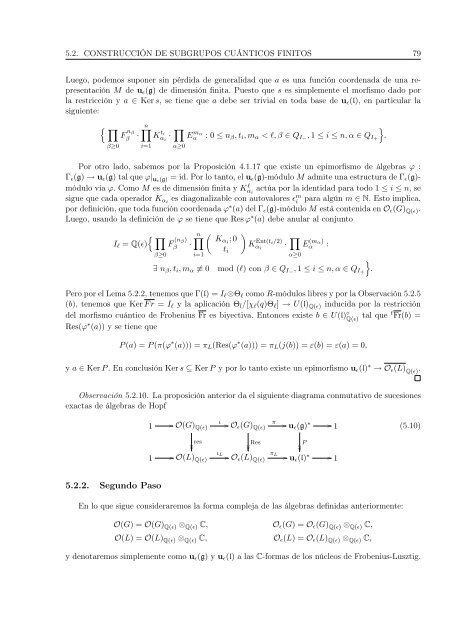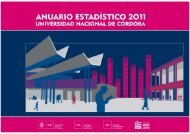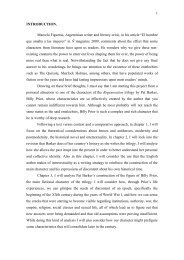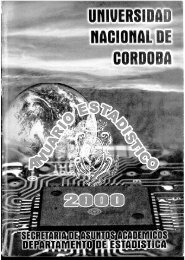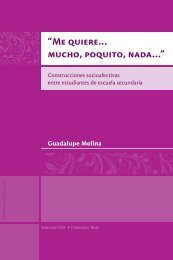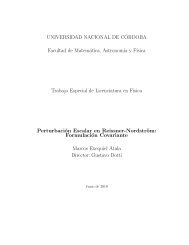Abrir - RDU - Universidad Nacional de Córdoba
Abrir - RDU - Universidad Nacional de Córdoba
Abrir - RDU - Universidad Nacional de Córdoba
Create successful ePaper yourself
Turn your PDF publications into a flip-book with our unique Google optimized e-Paper software.
5.2. CONSTRUCCIÓN DE SUBGRUPOS CUÁNTICOS FINITOS 79<br />
Luego, po<strong>de</strong>mos suponer sin pérdida <strong>de</strong> generalidad que a es una función coor<strong>de</strong>nada <strong>de</strong> una representación<br />
M <strong>de</strong> u ɛ (g) <strong>de</strong> dimensión finita. Puesto que s es simplemente el morfismo dado por<br />
la restricción y a ∈ Ker s, se tiene que a <strong>de</strong>be ser trivial en toda base <strong>de</strong> u ɛ (l), en particular la<br />
siguiente:<br />
{ ∏<br />
β≥0<br />
F n β<br />
β<br />
·<br />
n∏<br />
i=1<br />
K t i<br />
α i · ∏<br />
α≥0<br />
E m α<br />
α : 0 ≤ n β , t i , m α < l, β ∈ Q I− , 1 ≤ i ≤ n, α ∈ Q I+<br />
}.<br />
Por otro lado, sabemos por la Proposición 4.1.17 que existe un epimorfismo <strong>de</strong> álgebras ϕ :<br />
Γ ɛ (g) → u ɛ (g) tal que ϕ| uɛ (g) = id. Por lo tanto, el u ɛ (g)-módulo M admite una estructura <strong>de</strong> Γ ɛ (g)-<br />
módulo vía ϕ. Como M es <strong>de</strong> dimensión finita y Kα l i<br />
actúa por la i<strong>de</strong>ntidad para todo 1 ≤ i ≤ n, se<br />
sigue que cada operador K αi es diagonalizable con autovalores ɛ m i para algún m ∈ N. Esto implica,<br />
por <strong>de</strong>finición, que toda función coor<strong>de</strong>nada ϕ ∗ (a) <strong>de</strong>l Γ ɛ (g)-módulo M está contenida en O ɛ (G) Q(ɛ) .<br />
Luego, usando la <strong>de</strong>finición <strong>de</strong> ϕ se tiene que Res ϕ ∗ (a) <strong>de</strong>be anular al conjunto<br />
{ ∏<br />
I l = Q(ɛ)<br />
β≥0<br />
F (n β)<br />
β<br />
·<br />
n∏<br />
i=1<br />
( )<br />
Kαi ; 0<br />
K Ent(t i/2)<br />
α<br />
t i<br />
· ∏<br />
E (m α)<br />
α :<br />
i<br />
α≥0<br />
∃ n β , t i , m α ≢ 0 mod (l) con β ∈ Q I− , 1 ≤ i ≤ n, α ∈ Q I+<br />
}.<br />
Pero por el Lema 5.2.2, tenemos que Γ(l) = I l ⊗Θ l como R-módulos libres y por la Observación 5.2.5<br />
(b), tenemos que Ker F r = I l y la aplicación Θ l /[χ l (q)Θ l ] → U(l) Q(ɛ) inducida por la restricción<br />
<strong>de</strong>l morfismo cuántico <strong>de</strong> Frobenius Fr es biyectiva. Entonces existe b ∈ U(l) ◦ Q(ɛ) tal que t Fr(b) =<br />
Res(ϕ ∗ (a)) y se tiene que<br />
P (a) = P (π(ϕ ∗ (a))) = π L (Res(ϕ ∗ (a))) = π L (j(b)) = ε(b) = ε(a) = 0,<br />
y a ∈ Ker P . En conclusión Ker s ⊆ Ker P y por lo tanto existe un epimorfismo u ɛ (l) ∗ → O ɛ (L) Q(ɛ)<br />
.<br />
Observación 5.2.10. La proposición anterior da el siguiente diagrama conmutativo <strong>de</strong> sucesiones<br />
exactas <strong>de</strong> álgebras <strong>de</strong> Hopf<br />
1 ι<br />
O(G) Q(ɛ)<br />
<br />
π<br />
O ɛ (G) Q(ɛ)<br />
u ɛ (g) ∗<br />
1<br />
(5.10)<br />
res<br />
Res<br />
1 O(L) Q(ɛ)<br />
ι L<br />
O ɛ (L) Q(ɛ)<br />
π L u ɛ (l) ∗ 1<br />
P<br />
5.2.2. Segundo Paso<br />
En lo que sigue consi<strong>de</strong>raremos la forma compleja <strong>de</strong> las álgebras <strong>de</strong>finidas anteriormente:<br />
O(G) = O(G) Q(ɛ) ⊗ Q(ɛ) C, O ɛ (G) = O ɛ (G) Q(ɛ) ⊗ Q(ɛ) C,<br />
O(L) = O(L) Q(ɛ) ⊗ Q(ɛ) C, O ɛ (L) = O ɛ (L) Q(ɛ) ⊗ Q(ɛ) C,<br />
y <strong>de</strong>notaremos simplemente como u ɛ (g) y u ɛ (l) a las C-formas <strong>de</strong> los núcleos <strong>de</strong> Frobenius-Lusztig.


